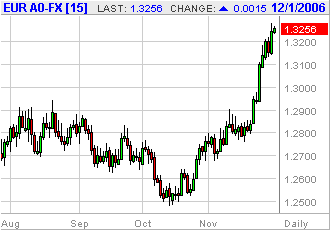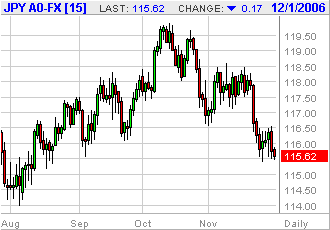US Dollar tumbles against most major currencies falling to historic lows against the British Pound and the Euro
Currencies / Strategic News Dec 01, 2006 - 12:15 AM GMTBy: Nadeem_Walayat
The dollar hits new lows against several major currencies, plunging to 1.96 Dollars to the British Pound, 1.33 Dollars to the European Euro, and to 115.5 Japanese Yen to the Dollar. The recent downtrend has been developing since early October, since when US interest rate expectations of further rises have shifted to a possibility of cuts in the new year in the face of a slowing economy on the back of a slump in the US housing market.
The downtrend was recently further reinforced by the outcome of the US election and rumors that the Chinease were planning on significantly diversifying their reserves away from the dollar, including comments made by the Governor of the Chinease Central bank as implying as such.
| British Pound (GBP/$) | Euro (EUR/$) |
 |
 |
| Japanese Yen ($/JPY) | Canadian Dollar ($/Can$) |
 |
 |
Technically the charts show a breakout to the downside of the dollar against most currencies. The dollar is clearly targeting $2 against the British Pound, having flirted with the mid 1.95's for approaching 18 months now, if that time is taken as the formation for a base for the next down leg in the dollar then that could signify a much more powerful decline in the dollar than most market commentators are estimating at this point in time, The $ could target a move against the Pound to $2.10. Against the Yen $1.10 seems likely, with the Euro likely to rally to Euro/$ 1.40. The strongest beneficiary will probably be the Pound, given that the housing market in the UK is still strong, and economic activity buoyant for the time being at least.
There is also the risk that the dollar may even collapse, if panic hits foreign holders of trillions of dollars of US assets, undoubtedly the worlds central banks will seek to avert a collapse and look to engineer a more orderly decline in the dollar. The Federal reserve may now be forced to keep interest rates on hold as a weakening dollar will feed through to already stubbornly high inflation figures, that continue to trend higher despite the slowing economy. Thus the Fed is unlikely to cut interest rates and should the dollar threaten a collapse, may even be forced to raise interest rates. This spells the specter of stagflation as a consequence of recession and a declining dollar during 2007 keeping inflation bubbling above the Feds target range of 1 to 2 %.
Related Articles
© 2005-2022 http://www.MarketOracle.co.uk - The Market Oracle is a FREE Daily Financial Markets Analysis & Forecasting online publication.



